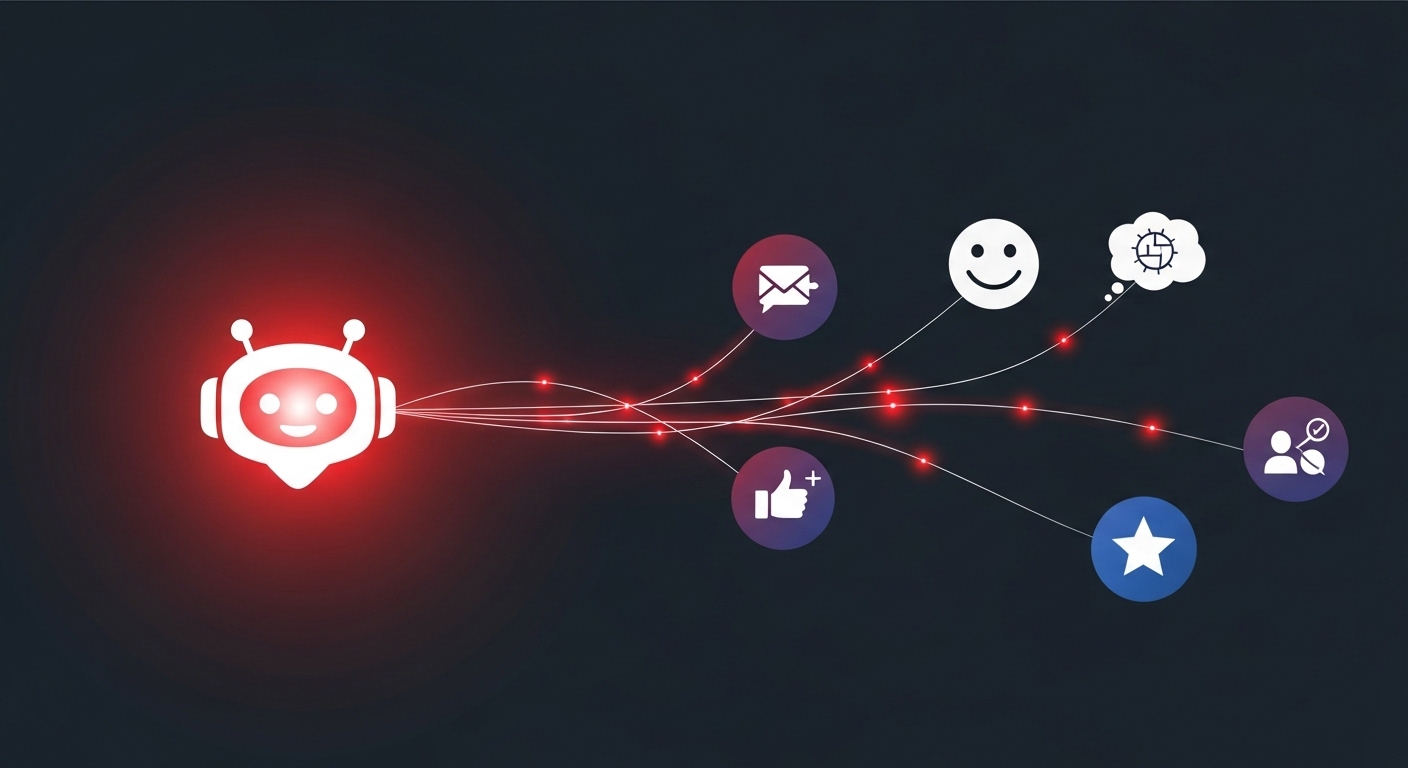AI Chatbots: More Than Basic Support — Creating Great Customer Experiences
AI chatbots and conversational marketing are changing how you talk to customers. They do more than just simple help; they offer advanced customer experiences through bots that find good sales leads, smart virtual helpers, and smooth handoffs to a human when needed. You can use smart language tools (NLP and NLG), find out what the customer is asking (intent detection), handle sales in the chat, and use bot platforms to qualify leads, make talks personal, and measure results—all while keeping your brand’s voice clear.
How AI Chatbots Have Grown
Chatbots have evolved from simple website help boxes to full-service assistants that find sales leads, book product demos, and pass the customer to a real person when necessary. You can expect modern chatbots to work everywhere: on your website, phone apps, text messages, and social media. They connect to your customer data (CRM) and track sales numbers, making your chat efforts directly tied to your revenue.
From Fixed Scripts to Smart Talks
Bots no longer rely just on rigid “if-this-then-that” rules. Modern bots use three smart methods: they figure out the customer’s intent, they remember the context of the talk, and they have plans for when they get confused. Tools allow you to add smart language understanding over scripted answers. This helps them handle unclear questions and qualify leads by gently asking questions over several turns, instead of hitting the customer with a rapid-fire quiz.
Understanding and Generating Language
Natural Language Processing (NLP) is how your bot understands what a user means and pulls out important details. Natural Language Generation (NLG) is how the bot creates its reply, which can range from a simple, fixed message to a custom-written, smart response. Today’s smart language models make the bots much more accurate and sound more human, allowing them to create personal, relevant replies for many customers at once.
How Machine Learning Makes Bots Smarter
Machine learning (ML) turns simple bots into helpers that learn and adapt. It makes the bot better at figuring out intent, choosing the best answer, and offering personalized deals based on past conversations. Training the bots on actual chat logs makes them more accurate, and running tests helps them learn the best way to talk to maximize sales goals.
To use ML, you must label data, run simple A/B tests, and watch how the bot’s understanding changes as user language evolves. You can speed up deployment by using large, pre-trained models and only fine-tuning them with a few thousand of your own company examples, instead of millions.
The Value of Conversational Marketing
Conversational marketing lets you turn a customer’s moment of interest into an action by using chat, lead-finding bots, and smooth handoffs to humans. This reduces frustration. Chatbots can handle up to 80% of simple questions, freeing up your sales team to focus on the most promising leads.
Instant Answers for Customers
Customers get responses in seconds and help is available 24/7. This turns people who are just browsing into buyers by answering questions before they leave (e-commerce businesses often lose ≈70% of sales at the cart). Offering instant chat and quick ways to check out right inside the conversation can recover many of those lost sales.
Changing Customer Habits
People now expect to use messaging-style chats everywhere—apps, website chat, and social media. Chat is no longer just a nice-to-have, especially for younger customers who prefer texting and continuous, contextual talks over being stuck in a phone menu.
You need to design conversations around the customer’s goal: use intent detection and a short, three-question process to find important users. Keep the talk going across different channels, and ensure human handoffs are clear so customers don’t have to repeat themselves.
Building Trust Through Chat
You build trust by giving consistent, personalized answers and clear signs about privacy. Bots that provide order updates, custom offers, and clear answers to questions reduce stress and encourage people to return. Visible pathways to a human agent are key.
Smart Bots Do Big Jobs
You use advanced bots for finding leads, suggesting products, solving problems on their own, managing subscriptions, and handling purchases right in the chat. Many companies find that bots can handle 60%+ of common interactions automatically, leading to response times under 60 seconds and a 20% to 30% increase in qualified leads.
| High-Value Job | Simple Description |
| Lead Qualification | Quick Q&A to check and send sales leads to the right team. |
| Product Discovery | AI acts as a personal shopper, giving tailored suggestions. |
| Troubleshooting/Self-Service | Automatically fixing common technical problems. |
| Conversational Commerce | Guiding customers through checkout and suggesting upgrades during the chat. |
In Detail:
- Lead Qualification: Bots ask 3–5 focused questions about company size or budget. This can cut qualification time by ∼70% and improve the rate of good leads by 15% to 25%.
- Product Discovery: Bots use product data and customer behavior to show a short, relevant list of items, explaining why each fits the user. This drives 10% to 20% better sales and reduces browsing time by up to 40%.
- Troubleshooting: Bots use FAQs and fixed decision paths to solve up to 60% to 70% of simple issues without a human, cutting the time needed to fix problems.
Designing a Good Conversation
First, map out the customer’s main paths, and decide on the top 5 things customers ask that relate to sales or support load. Design a short chat flow for each. Keep the bot’s memory short (3–5 turns), and immediately hand off to a human if the bot is unsure (low confidence), detects a customer is angry, or if rules demand escalation.
Bot Tone and Personality
Define the bot’s style (e.g., “friendly product guide”). Create three tone levels—businesslike, helpful, empathetic—and write 20–30 sample phrases for each. Test different tones to see which converts better (a 5% to 15% difference is common).
Handling Mistakes
Have a clear plan for when the bot doesn’t understand: rephrase the question, offer quick buttons, and if all else fails, escalate to a human. Set a rule to hand off when the bot’s confidence drops too low or after two failed tries. Keep track of how often the bot fails and aim for a failure rate under 5%.
Using Chatbots Everywhere
Connect your chatbots to a single back end so conversations, intent scores, and customer details follow the user between every touchpoint. This lets the bot and the human agent share the same context for faster solutions.
Website Integration
Embed chat boxes that pop up with timely questions or offers (e.g., when a user is about to leave the site). Set up the bot to fill out forms and send high-interest visitors to a live agent or demo booking, making sales faster.
Social Media (WhatsApp and Messenger)
Use WhatsApp and Messenger—where billions of customers already are—with quick replies and rich content. Design flows for order tracking and sales while following each platform’s rules. Ensure you have human fallback triggers to maintain quality on mobile.
Consistency Across All Channels
Define one single bot personality and use the same templates so the tone and language are consistent across web chat, WhatsApp, and text messages. Use a central resource for product facts so the bot gives the same information everywhere, reinforcing trust.
Smooth Bot-to-Human Handoff
Design the switch so the conversation never feels like it starts over: the bot keeps all the key information, confirms the customer’s goal, and clearly signals the transfer with an estimated wait time. Set rules to send complex issues (like refunds) to a human, while the bot handles simple tasks. Aim for under 30 seconds of visible wait time.
What Gets Sent to the Agent
Send the human agent a package of data: the last 8–12 messages, the bot’s guess at the intent, any extracted details (like order numbers), and the customer’s mood. Give the agent a quick, 2–3 line summary of the issue and what the bot already tried. This shortens the time it takes the human to handle the call and avoids making the customer repeat themselves.
Measuring How Well the Chatbot Works
Measure success using numbers that directly relate to your business goals: containment, sales conversion, lead quality, customer happiness, and revenue per chat.
Key Measures Beyond Speed
Look beyond speed and measure containment rate (how many problems the bot solves without a human), intent detection accuracy, and lead qualification quality. Good bots have containment rates between 60% and 80% and intent accuracy above 85%.
Tracking Sales from Chat
Calculate the sales that start from chat and divide by the total number of chat sessions. E-commerce funnels often convert at 8% to 12%. Use special tracking links and connect to your customer system to accurately track sales. Companies that follow up with leads in under 24 hours often see their lead conversion jump by 20% to 50%.
Customer Satisfaction (CSAT)
Collect customer satisfaction scores right after the talk. Top bots achieve CSAT scores of 85% or higher. Scores below 70% mean you need to redesign the bot or fix the escalation rules.
Improving Bot Performance with Data
Use dashboards to track intent accuracy and resolution time in real-time. Aim for intent detection over 85% and reduce the average time to handle an issue by 20% to 30%. Combine customer chat transcripts with the numbers, and run tests on different message phrasing.
User Behavior Analysis
Map out the conversation steps to find out where people leave the chat most often. Analyze why the bot failed to understand a question. Fixes that boost completion rates or improve the handoff to humans should be a priority.
Learning from Feedback
Embed short surveys (1–3 questions) or thumbs-up/down prompts to collect customer feedback right in the chat. Use this feedback to update the bot’s training data and chat flow. Fix simple issues within 48–72 hours and retrain the bot on complex issues over 30–90 days.
Privacy and Security
How you design your chat must protect personal data. Only collect and keep the necessary information for a limited time (e.g., 30–90 days). Keep clear records of data use and automatically delete data that is no longer needed.
Transparency Builds Trust
Be clear about privacy rules and how the bot works. Show a confidence score for its answers, link to the sources it used, and let users delete their conversation history. This makes the bot feel accountable.
The Future of Chatbots
Conversational strategies will move from simply reacting to issues to proactively helping customers. This will be driven by smart voice systems, models that guess customer needs, and very fast internet networks.
Voice Assistants are Growing
Customers will talk to brands using hands-free, voice-first devices like Amazon Alexa and Google Assistant, for ordering, booking appointments, and completing transactions without needing a screen.
Predicting What Customers Need
You will use real-time prediction to figure out the next best action—combining chat history and browsing behavior to send a hot lead to your sales team or trigger a personalized message that speeds up sales.
The Impact of 5G
The fast speeds of 5G will allow for rich, instant experiences—like live video shopping, instant language translation, and assistants that combine chat, voice, and augmented reality in one smooth interaction.
How to Set Up Advanced Chatbots
First, map out 3–5 important customer journeys (like finding a lead or handling returns). Design the intents and the handoff rules. Aim for the bot to handle 60% to 80% of issues by itself at first.
| Step | Focus | Action / Goal |
| Start-Up | High-value flows | Test 1–3 chat flows; measure sales, containment, and customer happiness. |
| Team Skills | Core roles | Need a project manager, language expert, writer, two developers, and an operations person. |
| Technology | Platform choice | Choose a platform that matches your needs for language understanding, scaling, and low latency. |
| Measurement | Key Goals | Track containment rate, handoff time, sales lift, and improvement over time. |
Export to Sheets
Setting Goals
Turn big business goals into measurable bot tasks. For example, if you need more qualified leads, the bot must collect 3–5 key details and send the lead to your sales system. If you need to cut costs, aim for a 20% to 30% drop in human support contacts within six months.
Success Stories
Chatbots have had a huge business impact:
Myntra: Bots helped shoppers with size guides and returns, leading to faster checkouts. Increased ticket bookings from assisted users by 20% and reduced call center traffic by ≈30%, saving significant operational costs.
HDFC Bank: Their AI assistant automated routine account queries (balance check, KYC status). Automated ∼35% of simple questions instantly and cut customer waiting time by ≈40% on mobile apps.
Goibibo: Their bot managed booking status (PNR), cancellations, and general timetable inquiries 24/7. ≈15% boost in online sales from guided customers and ∼45% faster resolution of return/exchange queries.



























